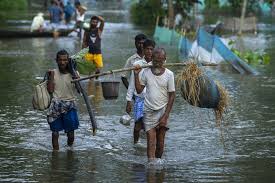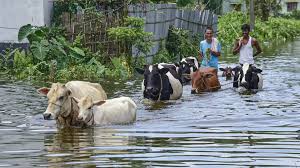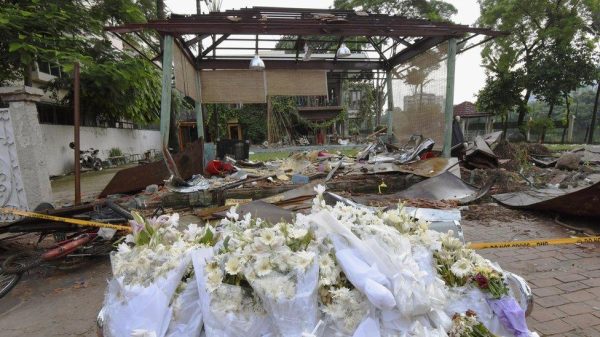As flood recedes, let’s think about its mitigation

- Update Time : Monday, July 15, 2024

As the flood situation in Assam has improved, let us think about its mitigation and if not let’s discuss its adaptation strategies. The second wave of flood snatched away the lives of 109 people and till Momay over 55,000 people remain in relief camps. Over 1,300 villages under Cachar, Dhubri, Nagaon, Dhemaji, Golaghat, Tamulpur, Chirang, Darrang, Goalpara, Karimganj, etc districts were under flood water that damaged more than 25,000 hectares of crop area. The annual flood embracing the incessant rainfalls devastated 10,50,000 domestic animals & poultry in Assam and it damaged a number of embankments, roads & bridges, buildings and other infrastructures.

Kaziranga National Park and Tiger Reserve in central Assam also went under flood water from the swollen Brahmaputra river and no less than 174 wild animals including 10 rhinos and 144 deers died due to drowning and other causes. The park authority also successfully rescued 133 animals including two rhino calves during the flood time and 116 animals were already released after necessary treatments. The field director Sonali Ghosh informed media persons that most of the forest camps (out of 233) inside the park went under flood water for many days.

The safe habitat for the largest population of single horn rhinoceros in the world eventually experiences flooding every year and as the core 430 square kilometer area goes under the water the animals take refuge in the highlands erected inside it. Many animals also cross the National Highway-715 on its southern border to climb the hilly areas of Karbi Anglong.
While crossing the highway, some precious animals are killed by the speeding vehicles and hence the authorities instruct the drivers to maintain the safe speed limit to avoid any unwanted incidents. Often the vehicles are escorted by the forest officials while crossing the park to prevent accidents with the fleeing animals. The Unesco world heritage site, which gives shelter to more than 2600 one-horned rhinos along with Asiatic elephants, water buffalo, tigers, etc faced a major flood in 2017, when over 350 animals died due to drowning and colliding with moving vehicles on the highway.

Prime Minister Narendra Modi, who has recently won a consecutive third term in New Delhi, assured full cooperation to the State government to deal with the deluge. Union home minister Amit Shah also called Assam chief minister Himanta Biswa Sarma to reassure all possible support from the Centre. Union ministers Sarbananda Sonowal and Pabitra Margherita, both hail from Assam, assessed the flood situation in various parts and assured the people that the governments in New Delhi and Dispur will look for a permanent solution to the recurring flood problem. Assam Governor Gulab Chand Kataria also visited some flood-ridden areas and took stock of the situation.
CM Sarma personally visited a number of flood devastated areas to review the ground situation and interacted with the displaced families. He also directed the State ministers, legislators and concerned officials to monitor the situation closely and take necessary actions as and when needed. State ministers Pijush Hazarika, Bimal Bora, Ranoj Pegu, Jayanta Mallaburuah, Jogen Mahan, Atul Bora, Keshav Mahanta, Ranjeet Kumar Dass, etc visited the affected villages and reviewed the rescue & relief operations.

Various social organisations like Rashtriya Swayamsevak Sangh extended support to the flood affected residents and provided phenyl, bleaching powder, livestock feed, etc to address the post-flood diseases. Assam’s neighbouring States namely Manipur, Arunachal Pradesh, Nagaland, Meghalaya, Tripura and Mizoram also experienced relentless rains and subsequent floods. Heavy rains inflated the rivers of Manipur like Imphal, Thoubal, Nambul, Iril, etc and submerged a large area of arable land and residential localities.
The overpowered Brahmaputra and other rivers inundated a large area of neighboring Bangladesh, where 40,000 people were forced to take shelter in government run relief camps. The recent wave of flood in Bangladesh affected 17 districts (out of 64 units). By now two million people are facing the flood furies, where ten individuals lost their lives due to the disaster.
Mitigating a natural disaster like the perennial flood in Assam may emerge as a challenging task but we must not lose hopes. The government schemes (mostly embankment-centric) are announced regularly and implemented accordingly but it hardly works fully. Once we talked about controlling the flood (so the flood control department existed) and now admit we have to adopt the ways to live with the flood.
Even if we cannot mitigate the flood menace, its devastating impact can be minimised with proper policies. Moreover, New Delhi must discuss with upper riparian countries like Bhutan and Tibet (now under China) for receiving timely alerts about unusual high rainfalls and hydropower activities (including damning water resources) in their places. It’s time for the government to redefine the flood adaptation measures keeping an eye on some positive outcomes for the common people.










Leave a Reply